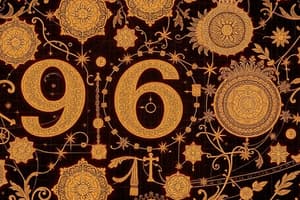Podcast
Questions and Answers
Which of the following is not a key branch of mathematics?
Which of the following is not a key branch of mathematics?
- Statistics (correct)
- Algebra
- Geometry
- Trigonometry
Which set of numbers includes only positive integers?
Which set of numbers includes only positive integers?
- Rational numbers
- Whole numbers
- Natural numbers (correct)
- Complex numbers
What is the result of the operation 5 × 0?
What is the result of the operation 5 × 0?
- Undefined
- 0 (correct)
- 10
- 5
Which operation is used to find the average of a set of numbers?
Which operation is used to find the average of a set of numbers?
What is the primary focus of differential calculus?
What is the primary focus of differential calculus?
Which of the following cannot be represented as a fraction?
Which of the following cannot be represented as a fraction?
Which geometric shape has only one curved surface?
Which geometric shape has only one curved surface?
What does the factorial of a number n, denoted as n!, represent?
What does the factorial of a number n, denoted as n!, represent?
Flashcards
Natural Numbers
Natural Numbers
The set of counting numbers, starting from 1.
Whole Numbers
Whole Numbers
Natural numbers plus zero.
Integers
Integers
Whole numbers and their negative counterparts.
Rational Numbers
Rational Numbers
Signup and view all the flashcards
Irrational Numbers
Irrational Numbers
Signup and view all the flashcards
Real Numbers
Real Numbers
Signup and view all the flashcards
Complex Numbers
Complex Numbers
Signup and view all the flashcards
Addition (+)
Addition (+)
Signup and view all the flashcards
Subtraction (-)
Subtraction (-)
Signup and view all the flashcards
Multiplication (×)
Multiplication (×)
Signup and view all the flashcards
Division (÷)
Division (÷)
Signup and view all the flashcards
Exponentiation (^)
Exponentiation (^)
Signup and view all the flashcards
Factorials (!)
Factorials (!)
Signup and view all the flashcards
Algebra
Algebra
Signup and view all the flashcards
Geometry
Geometry
Signup and view all the flashcards
Calculus
Calculus
Signup and view all the flashcards
Statistics
Statistics
Signup and view all the flashcards
Study Notes
Fundamental Concepts
- Mathematics is a science that studies quantities, structures, space, and change.
- It uses symbols and logical reasoning to represent and manipulate these concepts.
- Key branches of mathematics include arithmetic, algebra, geometry, calculus, and statistics.
- Mathematics is used in various fields such as science, engineering, computer science, and finance.
Number Systems
- Natural numbers (counting numbers): 1, 2, 3, ...
- Whole numbers: 0, 1, 2, 3, ... (includes zero)
- Integers: ..., -3, -2, -1, 0, 1, 2, 3, ... (positive and negative whole numbers)
- Rational numbers: numbers that can be expressed as a fraction p/q, where p and q are integers, and q is not zero.
- Irrational numbers: numbers that cannot be expressed as a fraction of two integers. Examples include √2 and π.
- Real numbers: the set of all rational and irrational numbers.
- Complex numbers: numbers that can be expressed in the form a + bi, where a and b are real numbers and i is the imaginary unit (i² = -1).
Arithmetic Operations
- Addition (+): Combining quantities.
- Subtraction (-): Finding the difference between quantities.
- Multiplication (× or ⋅): Repeated addition.
- Division (÷ or /): Repeated subtraction or finding how many times one quantity goes into another.
- Exponentiation (): Repeated multiplication.
- Factorials (!): The product of all positive integers less than or equal to a given positive integer.
Algebra
- Represents unknown quantities with variables (letters like x, y, z).
- Uses equations and inequalities to solve problems.
- Simplifying expressions, factoring, solving equations, and applying formulas ( quadratic formula, binomial theorem).
Geometry
- Studies shapes, sizes, positions, and properties of figures in space.
- Different types of figures and shapes like points, lines, angles, triangles, polygons, circles, etc.
- Measures and calculations involving shapes and their properties.
- Concepts such as area, perimeter, volume, surface area, and various geometric theorems (Pythagorean theorem, trigonometric ratios).
Calculus
- Deals with continuous change and its properties.
- Two main branches: differential calculus (study of rates of change) and integral calculus (study of accumulated quantities).
- Derivatives and integrals are fundamental tools to find slopes, areas, volumes, motion, etc.
Statistics
- Deals with collection, analysis, interpretation, and presentation of data.
- Statistical methods include measures of central tendency (mean, median, mode), measures of dispersion (variance, standard deviation), and probability calculations.
- Use of statistical graphs, charts, etc.
Logic
- Fundamental in mathematical thinking.
- Uses deductive and inductive reasoning to prove mathematical statements.
- Logical connectives (and, or, not, if-then, etc).
Studying That Suits You
Use AI to generate personalized quizzes and flashcards to suit your learning preferences.




